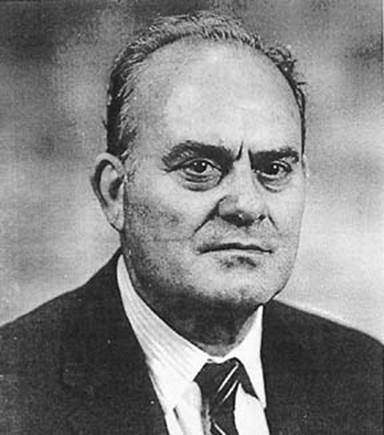


 تاريخ الرياضيات
تاريخ الرياضيات
 الرياضيات في الحضارات المختلفة
الرياضيات في الحضارات المختلفة 
 الرياضيات المتقطعة
الرياضيات المتقطعة
 الجبر
الجبر
 الهندسة
الهندسة 
 المعادلات التفاضلية و التكاملية
المعادلات التفاضلية و التكاملية 
 التحليل
التحليل
 علماء الرياضيات
علماء الرياضيات |
Read More
Date: 26-11-2017
Date: 3-12-2017
Date: 1-12-2017
|
Died: 19 January 1982 in Philadelphia, Pennsylvania, USA

Demetrios Magiros was a student at the University of Athens where he studied pure mathematics. He was awarded a doctorate in 1940 and was appointed to the National Technical University of Athens. His first appointment was as a lecturer in mechanics and geodesy but later he was promoted to professor of mathematics. During this period he published three papers on the catenary, all in 1946. These were: On the locus of the vertex of a variable catenary; The study of the tension of a variable catenary; and Diagrams of the tension of the cross-section in the suspension of hanging wires.
In 1949 Magiros went to the United States where he studied applied mathematics at Brown University, then the Courant Institute of Mathematical Sciences in New York, and finally at the Massachusetts Institute of Technology. He was then appointed as a research scientist at the IBM Watson Laboratory of Columbia University. His next position was with the Republic Aviation Corporation and at the Courant Institute. Magiros was then appointed as professor of mathematics and mechanics at Hofstra University in Hempstead, New York (founded in 1935 on land donated by businessman William S Hofstra). At the same time he acted as a consultant for the Space and Missile Center of the General Electric Company in Philadelphia. In 1960 Magiros left his position at Hofstra University to take up full time research activities at the Space and Missile Center of the General Electric Company. He continued to work for the General Electric Company for the rest of his career.
The book [1] contains 43 of Magiros' 54 papers. they are divided into three parts:
One of Magiros' main interests was on the stability of dynamical systems. In the paper On stability definitions of dynamical systems which he published in the Proceedings of the National Academy of Science U.S.A in 1965 he gives the following introduction:-
The dominant subject in the analysis of dynamical systems is the stability of the ensuing motion. Many fields of interest under current research involve dynamical systems. These range from fields such as astrodynamics, meteorology, and control systems to biology, chemistry, medicine, and economics. In each of these fields dynamical systems can be formulated, and their stability can be examined as special cases of stability problems in dynamics. During recent years the stability concepts of dynamical systems have been advanced, either by modifying old ideas or by creating new stability concepts. These advances permit a deeper penetration into the more profound stability problems.
In this note, stability concepts of physically realistic dynamical systems, which are mathematically consistent, are discussed. Based on appropriate interpretation of the effects of perturbations, acting on the system either momentarily or permanently, a unified promulgation of the three basic stability concepts in the sense of Lyapunov, Poincaré, and Lagrange is given. Specialised stability concepts, introduced within the basic concepts, are indicated by appropriate remarks, and some relationships between the stability concepts are emphasised, and the stability concepts are clarified by geometrical interpretations.
Magiros wrote other papers on stability such as The stability in the sense of Lyapunov, Poincaré and Lagrange of some precessional phenomena (1970) and Remarks on stability concepts of solutions of dynamical systems (1974). Other papers which Magiros wrote include these all published in 1976: On the linearization of nonlinear models of the phenomena. I. Linearization by exact methods which presents various "exact" methods of linearizing problems in differential equations; On the linearization of nonlinear models of phenomena. II. Linearization by approximate methods in which he points out that "approximate" linearizations may lose the whole qualitative behaviour of the original nonlinear equation; and Characteristic properties of linear and nonlinear systems in which he gives many examples, recalls the importance of identifying characteristic properties of solutions, such as the superposition property for linear systems, and the possibility of limit cycles and self-excited oscillations in nonlinear systems. Two papers which Magiros published in 1977 are: Nonlinear differential equations with several general solutions in which he gives specific devices for finding solutions of some nonlinear ordinary differential equations; and The general solutions of nonlinear differential equations as functions of their arbitrary constants presenting some nonlinear differential equations for which, surprisingly, some superposition does occur, that is, there are families of solutions depending linearly on arbitrary constants.
Tzafestas, in [3], talks about Magiros as a teacher:-
Magiros was an enthusiastic teacher with the talent to transmit both the depth and breadth of his knowledge. I personally remember his excellent lectures at N R C "Demokritos" in Athens (1973) on mathematical modelling and stability of dynamical systems. his impressive set of lecture notes ... covers a variety of topics from special functions and transforms to numerical methods for the solution of nonlinear differential equations and optimal control problems.
Books:
Articles:



|
|
|
|
"عادة ليلية" قد تكون المفتاح للوقاية من الخرف
|
|
|
|
|
|
|
ممتص الصدمات: طريقة عمله وأهميته وأبرز علامات تلفه
|
|
|
|
|
|
|
ضمن أسبوع الإرشاد النفسي.. جامعة العميد تُقيم أنشطةً ثقافية وتطويرية لطلبتها
|
|
|